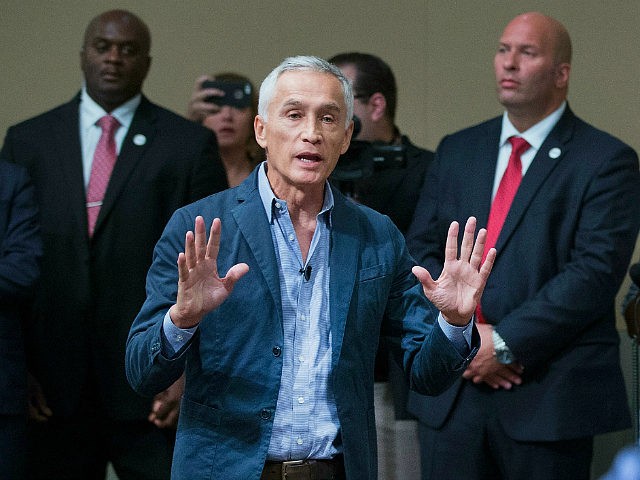The Mexican government must stop helping to enforce Americans’ immigration laws and must instead help poor migrants travel to the U.S. border, says Mexican immigrant and Univision anchor Jorge Ramos.
“The country itself has become the wall,” Ramos complained in an October 7th op-ed. “This has to change.”
Ramos objects to the anti-migration cooperation between the two trading partners, including Mexico’s success in reducing the transit of Central Americans up to the U.S. border. But instead of talking money, migration, and trade between two independent nations, Ramos writes about pride, status, and respect, saying:
We are talking about sovereignty, about dignity and basic respect for human rights, under circumstances where the safety of people fleeing gangs, violence and extreme poverty is at stake. Mexico should never forget that for decades it was an “immigrant exporter.” Now it must treat Central Americans with the same care and respect it has always demanded for Mexicans living in the United States.
It’s true: President Trump is using Mexico. And, against all logic, Mexico is letting him get away with it. This has to change.
Ramos came to the United States on a temporary student visa in 1983 and parlayed that into a news anchor job at a Spanish-language TV station in Los Angeles. He won a green card but only decided to become a citizen 25 years later, in 2008.
But Mexico has changed since Ramos left. A July 2019 poll, for example, shows that Mexicans’ view towards migration has turned hostile amid the conflict and turmoil of the cartel-managed migration:
More than 6 in 10 Mexicans say migrants are a burden on their country because they take jobs and benefits that should belong to Mexicans. A 55 percent majority supports deporting migrants who travel through Mexico to reach the United States.
Those findings defy the perception that Mexico — a country that has sent millions of its own migrants to the United States, sending billions of dollars in remittances — is sympathetic to the surge of Central Americans. Instead, the data suggests Mexicans have turned against the migrants transiting through their own country, expressing antipathy that would be familiar to many supporters of President Trump north of the border.
Yet Ramos says the relationship between his homeland Mexico and the United States is unequal, so Mexico must again help migrants reach the United States, regardless of the impact on his fellow nationals in the United States:
A salient feature of Mexico’s current foreign policy is precisely AMLO’s reluctance to confront anyone outside of the country. In short, American officials say what they want, and Mexico — almost always — goes along with it. The relationship between the two nations is by no means an egalitarian one.
…
What can Mexico do? It must refuse to be Mr. Trump’s wall, to be the United States’ waiting room and safety valve. Mexico must re-embrace its honorable tradition of protecting the persecuted and most vulnerable, whether they’re fleeing civil war in Spain or crime and hunger in Central America.
Immigration Numbers:
Each year, roughly four million young Americans join the workforce after graduating from high school or a university. This total includes about 800,000 Americans who graduate with skilled degrees in business or health care, engineering or science, software, or statistics.
But the federal government then imports about 1.1 million legal immigrants and refreshes a resident population of about 1.5 million white-collar visa workers — including approximately one million H-1B workers and spouses — and about 500,000 blue-collar visa workers. The government also prints more than one million work permits for new foreigners and rarely punishes companies for employing illegal migrants.
This policy of inflating the labor supply boosts economic growth and stock values for investors. The stimulus happens because the extra labor ensures that employers do not have to compete for American workers by offering higher wages and better working conditions.
The federal policy of flooding the market with cheap, foreign, white-collar graduates and blue-collar labor shifts wealth from young employees toward older investors. It also widens wealth gaps, reduces high-tech investment, increases state and local tax burdens, reduces marriage rates, and hurts children’s schools and college educations.
The cheap-labor economic strategy also pushes Americans away from high-tech careers, and it sidelines millions of marginalized Americans, including many who are now struggling with drug addiction.
The labor policy also moves business investment and wealth from the Heartland to the coastal cities, explodes rents and housing costs, undermines suburbia, shrivels real estate values in the Midwest, and rewards investors for creating low-tech, labor-intensive workplaces.
But President Donald Trump’s “Hire American” policy is boosting wages by capping immigration within a growing economy. The Census Bureau said September 10 that men who work full-time and year-round got an average earnings increase of 3.4 percent in 2018, pushing their median salaries up to $55,291. Women gained 3.3 percent in wages, to bring their median wages to $45,097 for full time, year-round work.

COMMENTS
Please let us know if you're having issues with commenting.